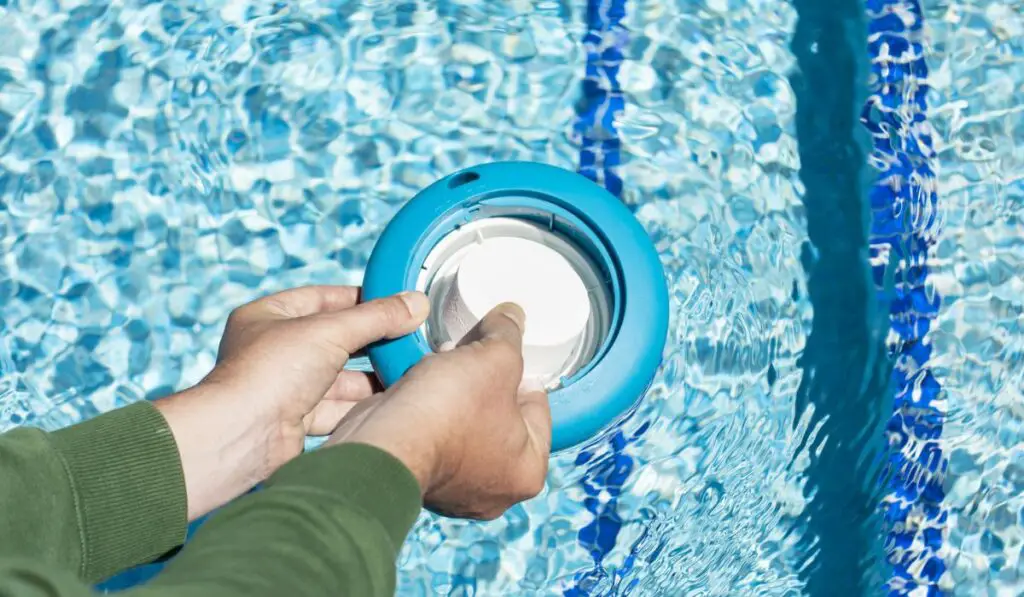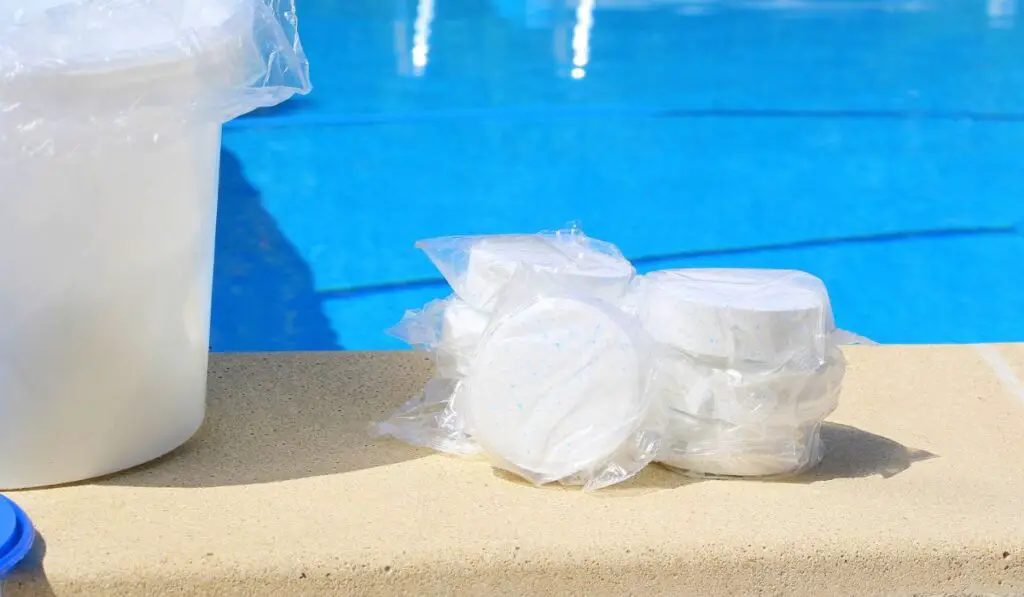Chlorinating your pool is one of the essential parts of pool maintenance. Retaining the right chlorine level makes the water safe to swim in and ensures that there’s no buildup of algae or bacteria. But that leaves people wondering how often they should chlorinate their pool, as well as what kind of chlorine they should use and when they should do it.
It’s best to chlorinate your pool two or three times a week to keep the levels between 1 and 3 ppm. You can also shock the pool every week or two by adding a lot of chlorine to kill off any bacteria. It’s also best to chlorinate your pool in the evening, because it evaporates quicker in the sun.
On top of regular use to keep your pool clean, chlorine is also necessary for shocking your pool. Let’s take a closer look at what chlorine actually is as well as how to use it the most effectively.
What is Chlorine?

Chlorine is an “oxidizing” chemical. Without going into too much detail, this means it kills bacteria and can purity water. Bromine and Iodine are also oxidizers, which is why they can accomplish the same thing
Although chlorine has many applications, including being part of cleaning products, one of the most common everyday uses is in pools. It can kill germs and viruses in the water, so it’s critical to keep the chlorine level of your water right.
How is Chlorinating Different From Shocking?
Although some people refer to chlorinating the pool and shocking it as the same process, there’s actually a difference between the two, despite the fact that shocking uses the same chemical.
Chlorinating the pool involves adding a little chlorine to get the levels back to between 1 and 3 ppm and keep the pool healthy. This is done more regularly than shocking, as the levels must be kept pretty consistent.
Shocking the pool is different in that it needs to be done less often. It involves adding a lot of chlorine to the pool — many times the usual amount — to raise the chlorine levels quickly. This effectively kills off bacteria that has built up in the pool and restores the water to safe cleanliness.
You should only have to shock your pool once every couple of weeks. When you do this, you should let the water sit for 24 hours and test the levels before you get back in.
If you get in when the chlorine levels are too high, it can cause skin and respiratory irritation and may be uncomfortable or even dangerous, especially in children and those with more sensitive health.
Signs Your Pool Needs to be Shocked
As well as doing it once every couple of weeks, you may occasionally find that you need to do it more often. Signs you need to shock your pool rather than just chlorinating it include:
- A build-up of algae on the walls or surface
- Cloudy water
- A strange smell in the water
If you notice any of these signs, take the time to shock it before getting back in the water. These are big indicators that the water is unclean, but some extra chlorine should get it back to normal.
How Much Chlorine Do I Need to Shock a Pool?
Usually, it’s around 1 lb per 10,000 gallons but when you buy pool shock (available on Amazon), the packaging should tell you exactly how much to use. Make sure to always read the instructions before putting something in your pool.
How Often Does Chlorine Need to Be Added to a Pool?
For the most part, you should only have to add chlorine two to three times a week. However, this will differ based on a few things:
- How heavily the pool is being used
- The amount of bacteria getting in there, e.g. debris from storms
- How often you scoop out that debris
- Whether the pool is sitting in direct sunlight
Keep testing the levels and you should be able to work out when the optimal times to keep adding chlorine are, as pools can differ based on these circumstances.
How to Determine the Amount of Chlorine Needed
The first thing you need to determine is how many gallons of water are in your pool. The first thing you should do is find the average depth, as you’ll need this for any formula. You can do this by measuring the deepest part of the pool, the most shallow, adding them together, and then dividing by two.
You will then need to use a formula to find how many gallons of water are in your pool. For circular pools, that formula is 3.14 x r² x average depth x 7.5 = volume. For rectangular or square pools, it’s length x width x average depth x 7.5 = volume.
To get the radius of a circle, measure the diameter (the widest point straight across) and then divide it by two. You can then plug this into the formula.
Irregular pools can be a little trickier, but the easiest way is to split them up into different shapes and add each answer together.
Once you know how many gallons of water your pool holds, you can figure out how much chlorine it needs to make it 1 to 3 ppm. To raise the chlorine levels by 1 ppm, multiply the number of gallons in your pool by 0.00013. This will tell you how much chlorine you need to add.
Which Type of Chlorine is Best?

There are multiple different types of chlorine available for your pool: liquid, granules, and tablets.
Granules are usually only best for smaller things like hot tubs or very small pools, leaving you to choose between liquid and tablets. Tablets (on Amazon) tend to be the better choice.
Tablets are more likely to include a stabilizer, which helps the chlorine last longer. They’re also pre-dosed so if you know how much chlorine your pool needs, you can simply drop the tablets in there and they’re good to go.
Liquid, on the other hand, is not stabilized, so you may need to add a separate stabilizer. It can also raise the pH of the pool, which means you’ll then have to test the pH after adding it and bring it back down. This is because the pH should stay between 7.2 and 7.8 to maintain safe swimming water.
If you can’t get your hands on some tablets, then liquid chlorine is fine to sanitize a pool, but it’s not the most convenient option.
What Time of Day is Best to Chlorinate Your Pool?
Chlorine burns up quickly in direct sunlight, so if you add it to your pool in the middle of the day then chances are you’re not getting the most out of it. Adding it in the evening is ideal because it can settle overnight and won’t have to face the sun until the next day.
If you do struggle with adding after the sun has set and can only do it during the day sometimes, that’s fine, but you may find that you may need to chlorinate your pool more often.
Can You Use an Alternative to Chlorine?
It is possible to use bleach to treat your pool, but you’ll have to be careful and look at the chemical makeup. Some bleaches contain a lot of synthetic chemicals, including colors and odors, and these should never be used in your pool. When possible, it’s always best to stick to straight chlorine.
